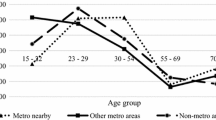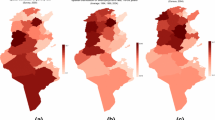Abstract
For a given subset of regions, origin–destination flows are decomposed into (1) flows from the subset to its complement, (2) flows from the complement to the subset, (3) flows within the subset, and (4) flows within the complement. With the last flow as the base category, we define three directional dummy variables. We analyze Japan’s inter-municipal migrations by age-sex group using a standard gravity model with directional dummy variables whose regional subsets consist of major cities. Migrations between major cities are more frequent in age groups 30–59, especially for men, than migrations between other municipalities. This observation reflects the fact that many business-related transitions are taking place between major cities. Models with only origin and destination dummies cannot detect such an effect.


Similar content being viewed by others
Notes
Greenwood (1970) is an early example. We owe this covariate to an anonymous referee. Biagi et al. (2011) use the difference between the values of the origin municipality variable and the destination municipality variable as a covariate. Although these covariates are directional, one cannot extract directional pair-specific factors because the absolute values of the pairs are the same and the signs are opposite.
Poot et al. (2016) use dummy variables for inter-urban migration flows, rural to urban migration flows, and urban to rural migration flows. They analyze migrations between urban areas, aggregate rural regions to one area. Hence the base of their directionally dummy variables is not base inter-rural flows. Their analysis includes international migration flows. Japan's census includes data on international immigration for each municipalities, but data on international emigration is not available.
Xiong and Chen (2014) show that Poisson regression estimation is not robust to a two-step data generation process in which generating zero flows and generating positive flows are distinct. Since the relationship between municipalities with zero migration is not fundamentally different from the relationship between municipalities with one or two migration, it seems that a two-step estimation of the data for inter-municipality movements is not appropriate.
The 2015 census is available, but the populations of three towns and villages in Fukushima Prefecture in 2015 are zero due to the Fukushima nuclear accident. It can cause some irregularities. We use the 2010 census to avoid irregularities.
Fielding and Ishikawa (2003, p. 248) note that "if so-called 'U-turn' migration in Japan, a migration to metropolitan regions when getting jobs or entering universities accompanied by a return to original regions, occurs in five years between censuses, no move is counted.".
We use "distGeo" function in " geosphere " library of R.
The estimated standard errors are two way (destinations and origins) cluster robust. We use "cluster.vcov" function of package "multi-wayvcov" of R. The age of each age-sex group is at the beginning of the 5-year interval (2005).
In the latter half of the twentieth century, the proportion of men leaving non-metropolitan prefectures at the time of first employment was higher than that of women (Inoue, Liaw 2004). Figure 1 does not mean that women aged 10–19 are more likely to move from other municipalities to major cities than men aged 10–19 move. The comparison is gender difference between migration from other municipalities to major cities and migration between other municipalities. To get information on absolute percentage comparisons, one must pool male and female data and add a gender dummy variable and interaction terms.
References
Beine, M., Docquier, F.: Ö, Ç,: Diasporas. J. Dev. Econ. 95, 30–41 (2011). https://doi.org/10.1016/j.jdeveco.2009.11.004
Biagi, B., Faggian, A., McCann, P.: Long and short distance migration in Italy: the role of economic, social and environmental characteristics. Spat. Econ. Anal. 6, 111–131 (2011). https://doi.org/10.1080/17421772.2010.540035
Cameron A. Colin. ,Trivedi, P. K.: Regression analysis of count data book—second edition. Cambridge University Press, Cambridge (2013)
Congdon, P.: Random-effects models for migration attractivity and retentivity: a Bayesian methodology. J. r. Stat. Soc. Stat. Soc. 173, 755–774 (2010). https://doi.org/10.1111/j.1467-985X.2009.00625.x
Fielding, A.J., Ishikawa, Y.: Migration and the life course in contemporary Japan. Geogr. Rev. Japan 76, 246–257 (2003). https://doi.org/10.4157/grj.76.12_882
Fielding, A.J.: Japan, internal migration trends and process since the 1950s, In Champion, T., Cooke, T. Shuttleworth, I. (eds.) Migration in the Developed World-Are We becoming Less Mobile?, pp.173–202. Routledge(2018).
Greenwood, M.J.: Lagged response in the decision to migrate. J. Reg. Sci. 10(3), 375–384 (1970). https://doi.org/10.1111/j.1467-9787.1970.tb00059.x
Inoue, T., Liaw, K.: Life-course perspective on some distinctive features of migration from non-metropolitan prefectures in Japan. Geogr. Rev. Japan Ser. B 77, 765–782 (2004). https://doi.org/10.4157/grj.77.765
Poot, J., Alimi, O., Cameron, M.P., Maré, D. C.: The gravity model of migration: the successful comeback of an ageing superstar in regional science, Investigaciones Regionales. J. Reg. Res. 36, 63–86(2016).;
Santos Silva, J.M.C., Tenreyro, S.: The log of gravity. Rev. Econ. Stat. 88(4), 641–658 (2006). Doi: https://doi.org/10.1162/rest.88.4.641
Santos Silva, J.M.C.,Tenreyro, S.: Further simulation evidence on the performance of the Poisson pseudo-maximum likelihood estimator. Econ. Lett. 112, 220–222 (2011). Doi https://doi.org/10.1016/j.econlet.2011.05.008
Xiong, B., Chen, S.: Estimating gravity equation models in the presence of sample selection and heteroscedasticity. Appl. Econ. 46, 2993–3003 (2014). https://doi.org/10.1080/00036846.2014.920481
Author information
Authors and Affiliations
Corresponding author
Additional information
Publisher's Note
Springer Nature remains neutral with regard to jurisdictional claims in published maps and institutional affiliations.
Supplementary Information
Below is the link to the electronic supplementary material.
Rights and permissions
About this article
Cite this article
Mizuno, T., Fujimoto, M. Directional dummies in gravity models: application to Japanese inter-municipal migration by age-sex group. Lett Spat Resour Sci 15, 161–171 (2022). https://doi.org/10.1007/s12076-021-00287-0
Received:
Accepted:
Published:
Issue Date:
DOI: https://doi.org/10.1007/s12076-021-00287-0




